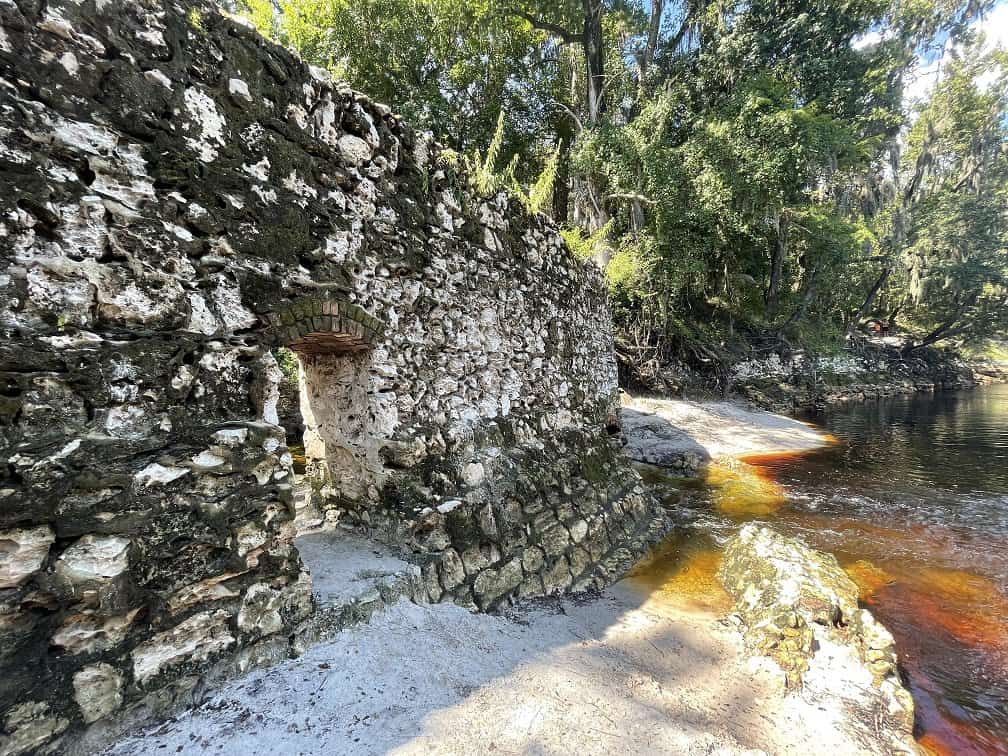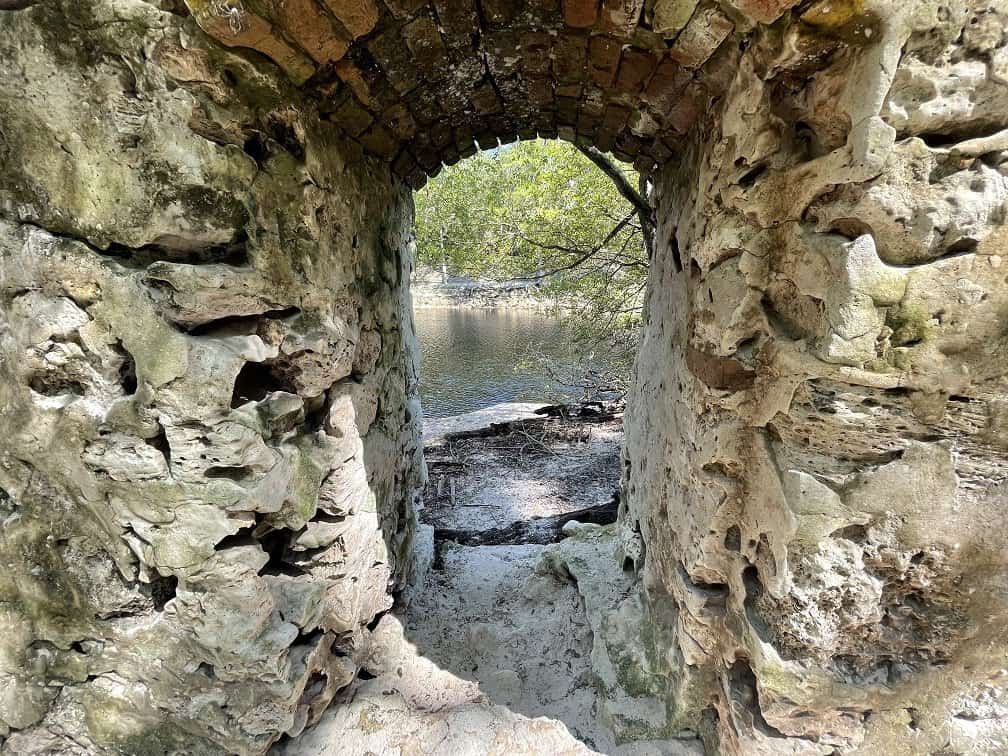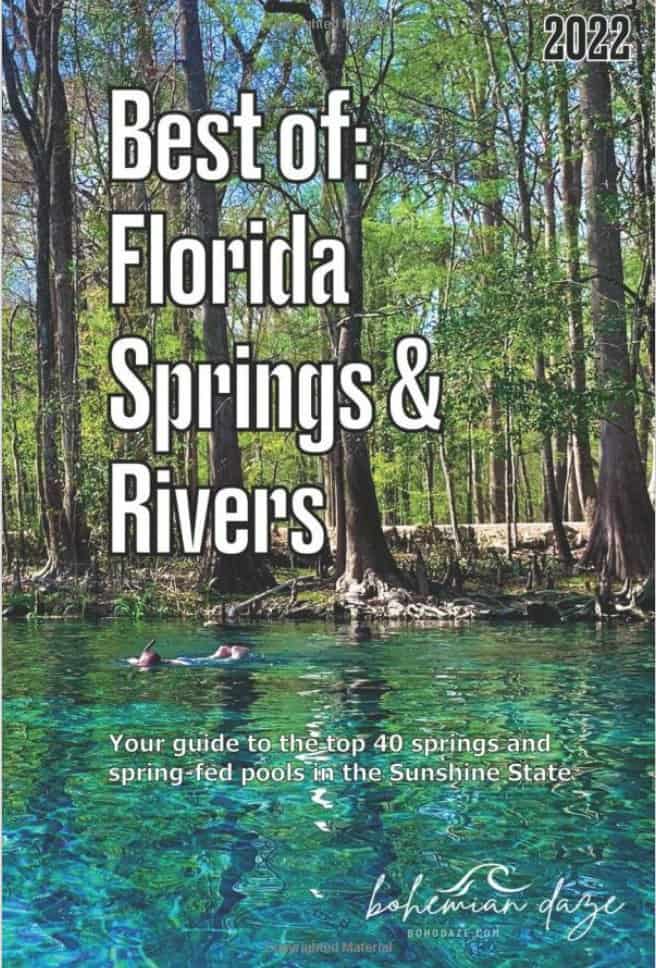Suwannee Springs Florida – The Oldest Spring in Florida
The natural springs of Suwannee Springs, formerly known as Suwannee Sulphur Springs, are located in Suwannee Springs, Florida, not far from Live Oak. Suwannee Springs used to be a popular tourist destination and hotel. Suwannee River, Water Management District, is presently in charge of its administration.
While it might not be one of the most visually stunning springs, it’s one of the oldest, with rich history and ruins worth your time. Opportunities for hiking, swimming, and paddling are available in the surroundings. The main spring is enclosed by a late 1890s construction of limestone rock measuring fifteen feet high and three feet thick. And despite the color of the water, you can swim in this spring.
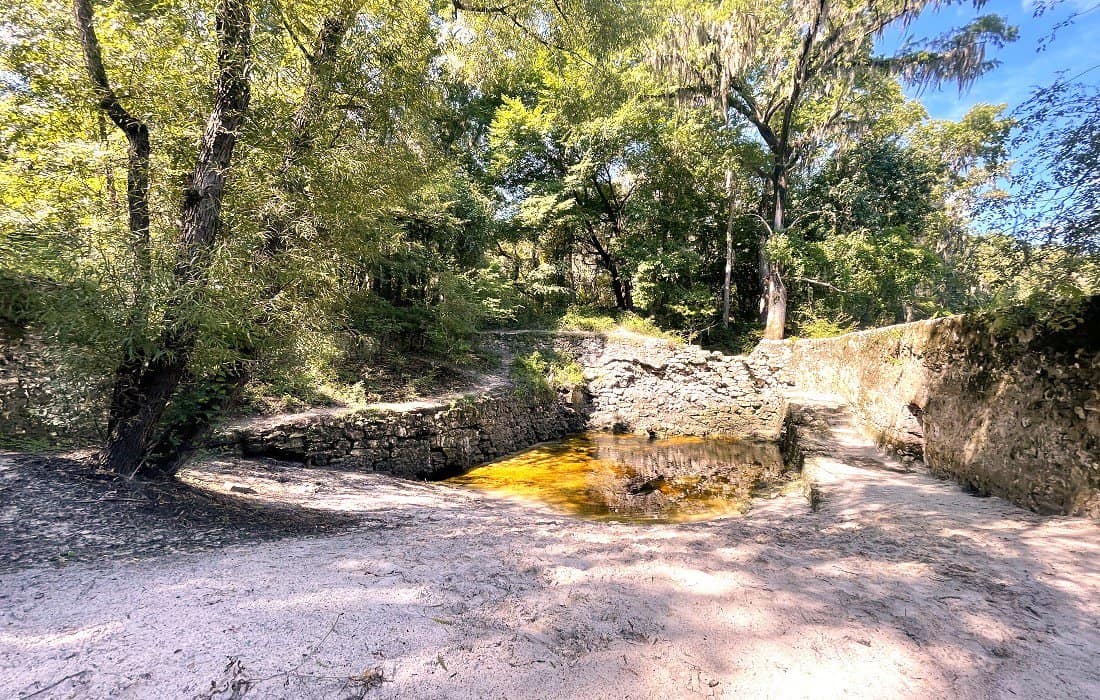
This post may contain affiliate links. Please read our disclosure and privacy policy for more information.
Why Visit Suwannee Springs?
One of Florida‘s first tourist spots was Suwannee Springs. The “healing sulfur waters” were popular among visitors from all over the east coast since they were said to treat everything from gout to marriage issues. The spring resides on the bank of the Suwannee River, and you can see the flow of the spring heading into the river. You can also see the spring head just by standing on the side; no need to brave the yellow water.
Perhaps more interesting is the limestone rock enclosure that has doorways carved out for you to access the river. It’s very castle-like and medieval. Then there are the stunning views of the sand-enhanced Suwannee River, offering incredible views.
It’s not a full day of activity unless you plan to fish or lay on the river’s sandbanks. However, it’s worth exploring while you are in the area.

History of Suwannee River
The Suwannee River has been a cornerstone of Florida‘s history since the beginning, and it was the site of Florida’s first tourism in the 1830s. The river also had a significant pivotal role in the American Civil War, with the Battle of Olustee fought near the confluence of the Suwannee and Withlacoochee Rivers.
The Suwannee River is recognized as a wild river by the government. In the Southeast United States, it is the only significant river that has not yet been met with modern-day life. From the Okefenokee Swamp in southern Georgia, the Suwannee runs across Florida to the Gulf of Mexico. It covers about 265 miles amid saline marshes, high limestone bluffs, hardwood hammocks, and swamps. Along the journey, there are more than three hundred documented springs.
The Song About The Suwannee River
In the 1800s, Stephen Foster established himself as the country’s first full-time songwriter. He composed more than 200 songs, many of which had melodies and lyrics that embodied the essence of the country. Foster struggled to finish a line in “Old Folks at Home” that connected his description of a lovely river with his feelings of desire for family and home. His brother allegedly chose the Suwannee River after consulting a global atlas. The song was on its way to making the Suwannee River well-known worldwide because the words suited.
Both the Suwannee River and Florida were foreign places to Foster. The song is an appropriate tribute to one’s sense of home for people familiar with the Suwannee’s deep waters and stark white limestone banks. It has also served as Florida’s official anthem. However, the song’s name is now “Florida, Where the Sawgrass Meets the Sky” – the official anthem of the State of Florida, originally written as a replacement for the state song.
Numerous freshwater springs are found along the river’s route, replenishing its flow. The river’s mouth is located near the fishing community of Suwannee on the Gulf of Mexico.
The average flow rate of Suwannee Springs, a second-magnitude spring, is 23.4 cubic feet per second. The spring spews out sulfurous, harsh water as it emerges from limestone that dates back to the Oligocene.
Ruins On Route To Suwannee Springs

Suwannee Springs Today
About 7.5 miles northeast of Live Oak, Suwannee Springs enters the Suwannee River from the southwest. Travel 4.3 miles north on US 129 starting at the I-10 and US 129 interchange north of Live Oak. At the solid waste collection site, turn right onto old US 129. Turn east on a graded road after traveling half a mile to reach the parking area for the spring.
Suwannee Springs consists of a minimum of six springs. On the south side of the Suwannee River, all are grouped in a sandy 100-foot stretch at the foot of a 35-foot-high bank. Within the rock walls of a bath house from the late 1800s is the main spring, whose water quality was tested. Clear, yellowish-greenish water collects behind the wall and pours over limestone stones coated with algae through an aperture at the base into the tannic Suwannee River.
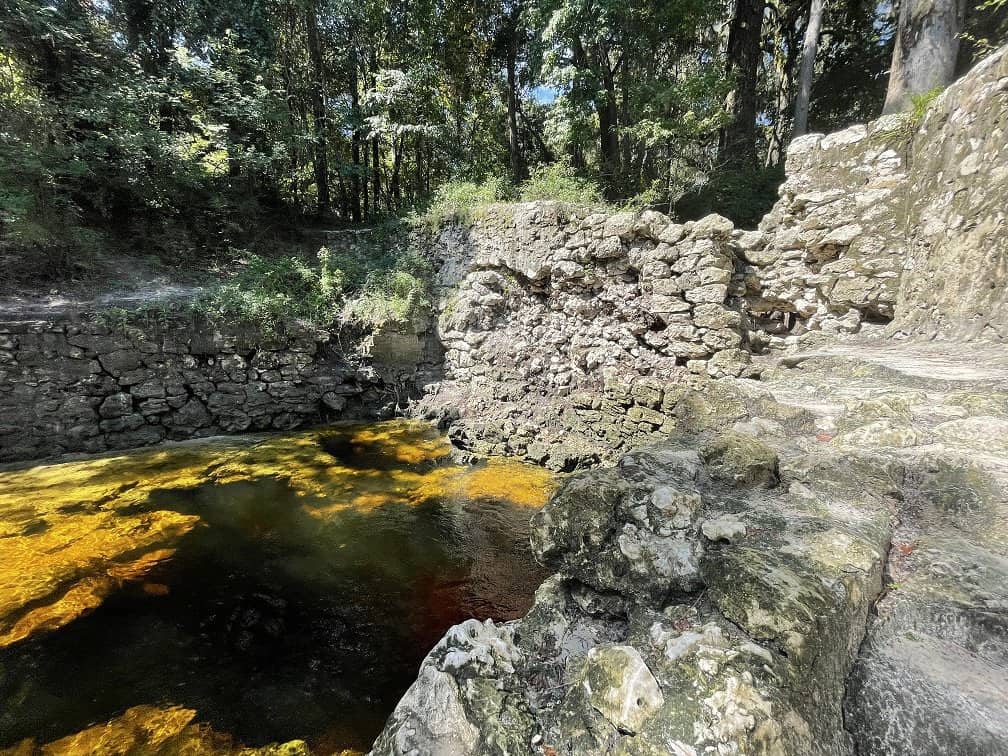
A little gator may be seen sunning itself on the shore of the river, which also has a beautiful landscape and a variety of birds. The Department of Forestry’s newest campground, Wood’s Ferry, features sleeping platforms that are covered and screened in, as well as a lamp and ceiling fan. Showers, flush toilets, and running water are also provided.
History of Suwannee Springs
Francis J. Ross, a former resident of Jacksonville, is the first known American to have settled in Suwannee Springs. He bought the springs and surrounding land from the United States in 1831 for $5,000 and started building a resort there. A Jacksonville newspaper from 1835 stated that Ross’ restaurant could seat 150 guests and that the main building’s hall could handle 200 people at once. The elderly and sick could enjoy the therapeutic waters in spring baths and showers, and stagecoach service between Tallahassee and Jacksonville made it possible to visit the springs weekly.

However, Suwannee Springs’ operation was severely restricted by the Second Seminole War (1835–1842). Ross was eventually persuaded to sell the resort in 1838 due to the 1837 global financial crisis.
Greater access was made possible by the Second Seminole War’s conclusion in 1842. After the Civil War, the owners of Suwannee Springs progressively extended the resort to include a large hotel, a trolley line that went down to the swimming area, exercise facilities, a bowling alley, a water bottling factory, and the stone walls that surround the springs to this day.
The First Suwannee Springs Hotel
Levi Scoville and Jesse Culpepper constructed the first significant postwar hotel at Suwannee Springs. A magnificent five-turreted wooden building with 125 rooms and a wonderful open central plaza. Sadly, the exquisite hotel was destroyed by fire on January 17, 1884, not long after it was finished. The building was described as “perhaps the greatest construction of the kind in the State” in a New York Times article. According to information from the Times, the fire began around 4:30 in the morning on the second level, above the kitchen, and due to gusts, it soon spread to the remainder of the structure.
Most of the predicted 100 guests were defectives, and most were from the North. A handful of the visitors who had to jump out of their second-story windows sustained damaged limbs. But, all the guests were said to have survived. Unfortunately, African-American servants were killed in the fire. The tragedy was so tragic that a special train was dispatched from Jacksonville to assist in providing relief for the numerous relocated guests. The hotel had only $51,000 in insurance coverage while valued at $95,000.
The Second Suwannee Springs Hotel
Following the fire of the first postwar hotel, the proprietors realized that trying to put all their eggs in one basket was not the best course of action. A second hotel, in 1885, was small with just 25 rooms and made of brick. The addition of cottages ensured that no cottage would lose all its guests in a single fire. The second hotel caught fire in November 1901. The proprietors were able to save the 18 nearby cottages and the hotel annex, which was located more than 100 feet away. The third postwar hotel was built as the second hotel’s annex, and visitors were still welcomed at the cottages through the first half of the twentieth century.
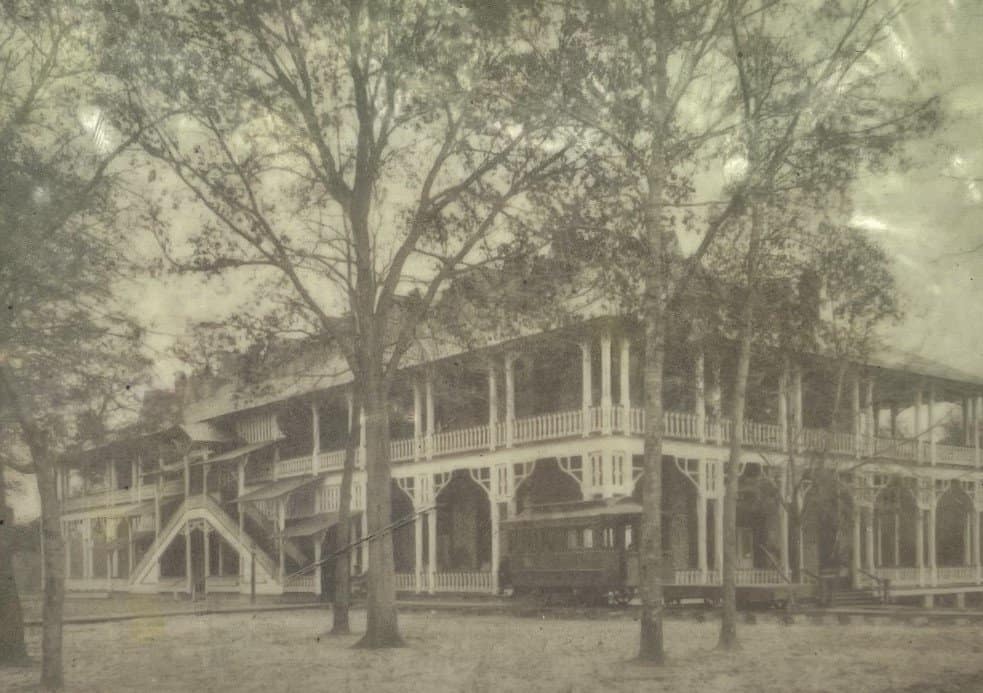
As scientific evidence began to show that sulfur did not hold miraculous healing powers, the visitors became fewer and fewer. The community of Suwannee Springs eventually dried up; fire finally destroyed the third hotel in 1925, and most of the guest cabins have since vanished. Repeated discussions about rebuilding a hotel and cabins have met with little commercial interest, and the site is now a local park.
Paddle Boats on The Suwannee River
As soon as the Civil War ended, steamboats ran on the Suwannee at full speed. Two decks and a flat bottom characterized them. Two stacks were attached to the wood-fired ovens. On top was the pilothouse. Some paddle boats were just for freight. Others let passenger travel on the top deck.
Suwannee River steamboats traveled to the Gulf of Mexico. Once at Cedar Key, a thriving port fifteen miles south of the Suwannee. Several steamboats on the Suwannee, such as the Louisa, the David Yulee, and the Belle of the Suwannee. Hawkinsville was the last boat to operate on the river. A short distance from the river’s mouth, she tied up in 1923 along Old Town’s bank for the last time.
The Madison
One of the first paddle boats was The Madison. A floating country store, the Madison, was on the Suwannee before the Civil War. James Tucker was the captain and operator of the sternwheeler. In exchange for money, he brought cowhides, beef, chickens, eggs, hogs, deerskins, venison, beeswax, honey, gum resin, lumber, cotton, or whatever else he could find.
Some folks asked for the Madison to help deliver corn when Captain Tucker received orders to report to Virginia. It was a tough time, and people were starving. After the Madison was sunk in the Suwannee, Captain Tucker said yes. You can still see her hull at White Springs when the river isn’t too high and overflowing.
Related: There is a sunken steamboat in Hawkinsville on the Suwannee River near Old Town and Fanning Springs, easily visible to anyone who wants to look.
Best Of Florida Springs & Rivers
If you really love springs, then you need this book! Florida is home to over 1000 natural springs between the sun-soaked beaches of the Gulf of Mexico and the Atlantic Ocean, which have drawn people to the state for thousands of years. Long before theme parks came to town, the freshwater springs were the top tourist attraction in the state. Join us across the state to explore 40 of the best springs in Florida that you can still visit today. Filled with vivid photos from the past and present, this guide will show you a side of the Sunshine State you won’t see in commercials. Complete with information on conservation and a key for activities offered, this book is a must-have for locals and tourists alike.
Bridges on The Suwannee River
Although there used to be more, the river is crossed by roughly ten significant bridges, some exclusively accessible to railroads and others to pedestrians. There are instances when a highway bridge stands next to a railroad trestle bridge—each representing a different historical period of the waterway. For example, the Hillman Bridge, where the original U.S. 90 crossed the river, is directly adjacent to the old abandoned railroad bridge.
The high water levels from some of the previous flooding that the river experienced were frequently visible on the bridges. Previous floods with tannin-colored stains marked bell’s bridge. Some of the more recent bridges, such as the Hal W. Adams Bridge at Luraville, which connects the counties of Suwannee and Lafayette, have a highly opulent appearance.
The Bridge To Nowhere
Florida’s Suwannee Springs Bridge, also known as Graffiti Bridge and Bridge to Nowhere. It is owned by the state and has long been forgotten. This beautiful bridge was built in 1931 by Austin Brothers Bridge Company and served as the area’s main street for many years. You can see this bridge from the banks of the river while you are at the spring. You can also drive up to it and walk along it.


There is an informational plaque on the standalone bridge span in Fanning Springs State Park near U.S. 19 at the river. It notes that the structure was first completed in 1934 and named the Benjamin Chaires Bridge in honor of a local pioneer resident of Dixie County. Locals were so happy with the bridge’s completion in 1934 that they held a square dance on the bridge itself.
A more contemporary bridge was built instead, and the original Chaires Bridge was relocated to a park next to the river. Naturally, bridges provide a helpful service by allowing people to go from one side of the canal to the other, but they can also be beautiful to view from the river’s level.
FAQs About Suwannee Springs
Closing Thoughts
One of the first tourist sites in Florida is Suwannee Springs. While it was a healing paradise that people traveled from the east coast to visit, it now lies in ruins. The location had numerous cottages, a bathhouse, and four hotels between the Civil War and the 1920s. For the sole purpose of handling the tourist traffic to the springs, a spur railroad line was built. In 1925, the final hotel burned destroyed.
There is still the spring house, two cabins, and a few outbuildings today, making this enjoyable for anyone to explore!
Here are some of the most popular springs in Florida:
- Blue Spring – Florida
- Crystal River & Three Sisters Spring
- De Leon Springs, aka “Ponce De Leon Springs State Park”
- Devil’s Den Florida – A Prehistoric Spring
- Homosassa Springs Florida
- Kelly Park – Rock Springs
- Kings Landing, Florida, and The Iconic Emerald Cut
- Rainbow Springs State Park
- Royal Springs – Suwannee County’s Hidden Gem
- Silver Glen Springs, Florida
- Silver Springs – One Of Florida’s Most Famous Springs
- Weeki Wachee Springs
- Weeki Wachee Spring’s Buccaneer Bay Water Park
- Wekiva Island, Florida – The Locals Retreat
- Wekiva Falls RV Resort – Sorrento’s Hidden Spring
We participate in the Amazon Services LLC Associates Program, an affiliate advertising program designed to provide a means for us to earn fees by linking to Amazon.com and affiliated sites.
Brit On The Move™ Travel Resources
Ready to book your next trip? Use these resources that work:
Was the flight canceled or delayed? Find out if you are eligible for compensation with AirHelp.
- Book your Hotel: Find the best prices; use Booking.com
- Find Apartment Rentals: You will find the best prices on apartment rentals with Booking.com’s Apartment Finder.
- Travel Insurance: Don’t leave home without it. View our suggestions to help you decide which travel insurance is for you: Travel Insurance Guide.
- Want to earn tons of points and make your next trip accessible? Check out our recommendations for Travel Credit Cards.
- Want To Take A Volunteer Vacation or a Working Holiday? Check out the complete guide to how here!
- Want to Shop For Travel Accessories? Check out our Travel Shop.
Need more help planning your trip? Visit our Resources Page, which highlights the great companies we use for traveling.
